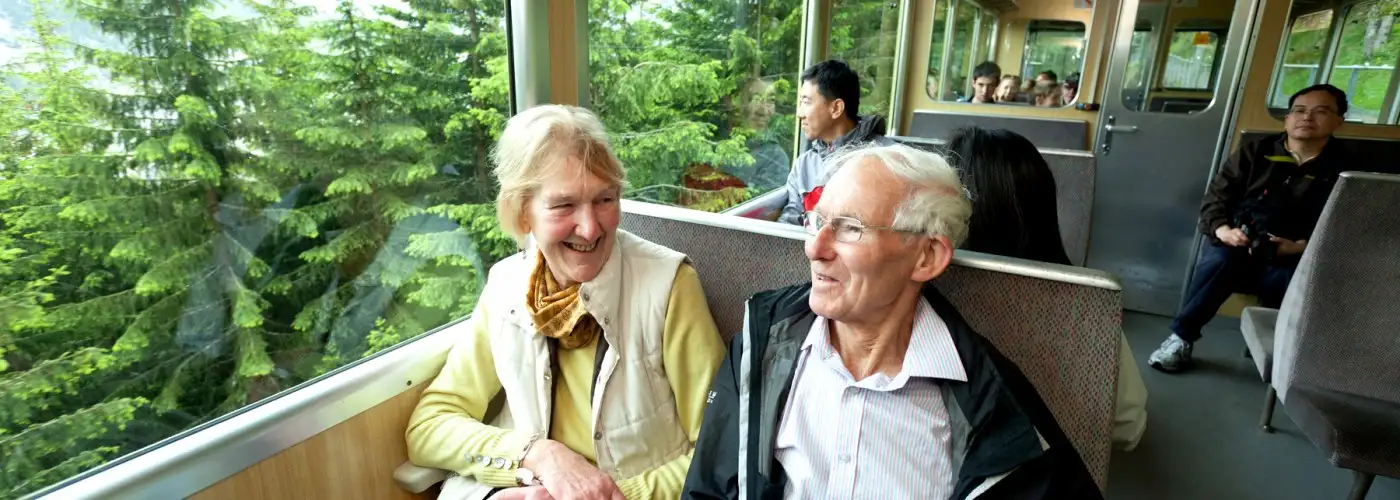Great European train stations stir my wanderlust. In Munich, about to catch a train, I stand under the station’s towering steel and glass rooftop and study the big schedule board. It lists a dozen departures. Every few minutes, the letters and numbers on each line change as, one by one, cities and departure times work their way to the top and then disappear. I’m surrounded by Europeans on the move—businessmen in tight neckties, giddy teenagers, families, porters pushing handcarts.
For many tourists, the pleasure of journeying along Europe’s well-organized rail system really is as good as the destination. Train travel isn’t as flexible as driving, but it’s less stressful. I’d rather watch the landscape instead of fixing my eyes on the road. On a train, I can forget about parking hassles, confusing road signs, bathroom stops, or Italian drivers.
A train traveler’s biggest pre-trip decision is whether to get a rail pass, point-to-point tickets, or a mix of both. It pays to do the math by adding up the approximate ticket costs for your itinerary. European rail fares are based primarily on distance traveled, so if you’ll be on the train for just short trips, point-to-point tickets are usually a better match.
The more miles you’ll cover on the train, however, the more likely it is that a rail pass makes sense. The Eurail Pass is the most common multi-country pass, and many countries sell rail passes good for use in their country only. Most rail passes give you a certain number of train travel days to use within a longer “window” of time (for example, any ten days within a two-month period). You can sprinkle these travel days throughout your trip (ideally to cover long rides), and pay out of pocket for short trips.
Online schedule sites can help with planning. Each country’s national rail company has its own website, but the site operated by Deutsche Bahn, the German rail company, has schedules for virtually all of Europe and can be the best place to start.
Riding the rails is much the same all over Europe. Ticket windows handle your ticket and reservation needs; or you can usually buy a ticket at a travel agency to spare yourself the long lines. Be sure, when necessary, that your ticket or rail pass is validated before boarding. Many express trains require an advance reservation; it’s smart to ask.
Wondering whether to splurge for first class? Nearly every train has both first- and second-class cars—each going at precisely the same speed. First class is cushier, generally with three seats across and fewer passengers. Second class comes with four seats across and more people. But today’s trains are so comfortable that the new second class feels as slick as the old first class—at a third to half the cost. I don’t bother to pay the premium for first class except during very busy times, such as holiday weekends.
When you’re on the platform, look for the posted train composition charts that show the order of cars (first class, second class, and dining car) for your train. With this chart, you’ll know where to wait on the platform so that when the train stops, you’re already positioned to step right onto your car.
Nowadays, the old clackity-clackity rhythm of the rails has been replaced by the nearly silent swoosh of bullet trains. These super-fast trains are making European rail travel more time-efficient than ever.
Take the speedy Eurostar train, which barrels between Paris and London in about 2.5 hours via the Chunnel. Within minutes of departure, the train is zipping at 180 mph across the French countryside. The train travels so fast that, where the tracks parallel the highway, the cars you pass seem to be standing still.
Sleeping while rolling down the tracks can save time and money. With night trains, you can easily have dinner in Paris, sleep on the train, and have breakfast in Venice, Munich, or Madrid. If a train ride is six hours or longer, it’s worth considering whether a flight (try Kayak for low-cost flight options) or an overnight train is more convenient.
Sleeping cars require a paid reservation beyond the regular ticket price, but for less than the cost of a simple hotel bed, you get your own bunk with clean linen and an attendant who comes and goes as you sleep. What you miss in scenery is more than made up for by the entire extra day you gain for sightseeing.
Trains remain the quintessentially European way to go and are the best option for romantics. Across the Continent, train stations are being remodeled into gleaming transportation hubs. Whether old or new, each station is a temple of travel. Just pick a platform … and explore Europe.
(Photo: Dominic Bonuccelli)
Rick Steves (www.ricksteves.com) writes European travel guidebooks and hosts travel shows on public television and public radio. Email him at [email protected] and follow his blog on Facebook.
You Might Also Like:
We hand-pick everything we recommend and select items through testing and reviews. Some products are sent to us free of charge with no incentive to offer a favorable review. We offer our unbiased opinions and do not accept compensation to review products. All items are in stock and prices are accurate at the time of publication. If you buy something through our links, we may earn a commission.
Related
Top Fares From
Today's Top Travel Deals
Brought to you by ShermansTravel
Kenya: 14-Night Tour, Incl. Tanzania &...
smarTours
 vacation
$7125+
vacation
$7125+
7-Night Caribbean Round-Trip Cruise From Orlando:...
Norwegian Cruise Line
 cruise
$739+
cruise
$739+
Ohio: Daily Car Rentals from Cincinnati
85OFF.com
 Car Rental
$19+
Car Rental
$19+




